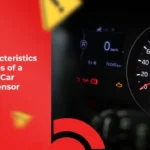Learn about the Functions, Workings, and Features of the Driver Monitoring System!
Posted on May 13, 2025 by Nur Wachda Mihmidati

Driver Monitoring System (DMS) is a technology used in vehicles to monitor driver activity and behavior. The system typically uses cameras and sensors located inside the vehicle cabin to detect driver activities such as head movements, body position, and driver presence in the seat.
DMS can help reduce the risk of accidents because it can detect signs of fatigue, inattention, and other driver distractions. The system can also provide warnings to drivers if they are too tired or if they start to take their eyes off the road.
DMS can also be used to collect data on driver behavior and used to help companies develop training programs or accident prevention programs. The use of DMS is increasingly common in the transportation sector, especially in the truck and bus industry, where drivers often face strict time demands and long mileage.
DMS Functions for Fleet
Driver Monitoring System (DMS) is a technology that helps monitor driver activity and behavior while driving a fleet. The most important function of DMS is to improve driver safety and efficiency, as well as reduce the risk of accidents and the financial losses associated with accidents. Some of the DMS functions that can benefit fleets are as follows:
Detecting Driver Boredom and Distraction
The DMS can detect signs of driver boredom and inattention, such as drowsiness or prolonged staring at a cell phone screen. The DMS can then alert the driver or fleet manager to take a break or reduce cell phone use while driving.
Monitoring the Driver’s Physical Condition
The DMS can monitor the driver’s physical condition, such as head movements or frequent eye closures, so as to alert the driver or fleet manager to stop and rest if necessary. DMS can also help prevent accidents caused by health issues, such as heart attacks or strokes.
Monitoring Road and Traffic Conditions
The DMS can also monitor road and traffic conditions, such as speed and distance between vehicles, so that it can provide alerts to drivers or fleet managers to reduce speed or avoid hazards that may occur on the road.
Helps Increase Productivity
DMS can help improve fleet productivity by monitoring driver driving time and providing data on driver patterns and driving behavior. With this data, fleet managers can develop more effective training and accident prevention programs and improve driver efficiency.
Reduce Operating Costs
DMS can help reduce fleet operating costs by monitoring driver speed and driving behavior. By reducing speed and avoiding risky driving actions, fleets can reduce accidents and vehicle damage, thereby reducing repair costs and insurance costs.
DMS is an essential technology for fleets looking to improve driver safety and operational efficiency. DMS helps reduce the risk of accidents and financial losses, and improves driver productivity and efficiency. By utilizing DMS, fleets can improve safety, efficiency, and productivity in operating their fleet.
How the Driver Monitoring System Works
The Driver Monitoring System (DMS) works by using sensors and cameras installed inside the vehicle cabin to monitor the driver’s behavior and activities. Here is how the DMS works in more depth:
Sensors and Camera
DMS uses sensors and cameras to monitor driver activities. Sensors can monitor activities such as head movements and body position, while cameras can monitor driver activities such as head position, eye position, and direction of view.
Data Analysis
After collecting the data, the DMS will analyze the information to determine whether the driver is safe or not. This analysis typically involves the use of artificial intelligence (AI) and machine learning (ML) technologies to identify potentially dangerous patterns of driver behavior.
Giving Warnings
If the DMS detects potentially dangerous driver behavior, such as drowsiness or lack of focus, the system will provide a warning to the driver or fleet manager. The warning can be in the form of an audible or visual alert, such as a warning light or vibration on the driver’s seat.
Record Data
The DMS can also record data and store it for later use. This data can be used to track driver behavior patterns, provide feedback to drivers and fleet managers, and be used for training and performance evaluation purposes.
Integration with Other Systems
The DMS can be integrated with other systems in the vehicle, such as the navigation system, to provide additional information to the driver. It can also be linked with other safety systems, such as emergency braking systems, to reduce the risk of accidents.
DMS is a complex technology and requires a lot of data processing to work effectively. However, with the use of artificial intelligence and machine learning technologies, DMS can be a highly effective tool to improve driver safety and efficiency.
Features of the Driver Monitoring System
The following are some of the features commonly available on a Driver Monitoring System (DMS):
Head Position Monitoring
The DMS can monitor the driver’s head position to identify whether the driver is sleepy or unfocused. If the driver is detected to be sleeping or in an unnatural position, the DMS will alert the driver or fleet manager.
Eye Monitoring and Viewing Direction
The DMS can also monitor the driver’s eye position and direction of view to identify whether the driver is focused on the road or not. If the driver is detected to be unfocused, the DMS will alert the driver or fleet manager.
Head and Body Activity Monitoring
The DMS can monitor the driver’s head and body activity to identify whether the driver is feeling tired or experiencing other health issues. If a driver is detected to be in an unsafe condition, the DMS will alert the driver or fleet manager.
Accident Policy Identification
DMS can also assist fleet managers in developing accident policies and providing feedback to drivers. The data collected by the DMS can be used to identify potentially dangerous driver behavior patterns and provide training to drivers who need it.
Record Data
The DMS can record data and store it for later use. This data can be used to track driver behavior patterns, provide feedback to drivers and fleet managers, and be used for training and performance evaluation purposes.
Integration with Other Systems
The DMS can be integrated with other systems in the vehicle, such as the navigation system, to provide additional information to the driver. It can also be linked with other safety systems, such as emergency braking systems, to reduce the risk of accidents.
The features of a Driver Monitoring System continue to evolve in line with technological developments and user needs. However, the features mentioned above are commonly available on DMS and can help improve driver safety and fleet efficiency.
Types of Driver Monitoring System (DMS)
In the modern automotive world, driving safety is a top priority. One of the rapidly developing technologies to support this is the Driver Monitoring System (DMS). These systems are designed to monitor a driver’s physical condition and behavior in real-time to reduce the risk of accidents due to fatigue, distraction, or medical conditions.
The following are several types of DMS based on the technological approach used:
1. Eye Tracking DMS
This type utilizes cameras and sensors to monitor the driver’s eye and eyelid movements. This system can:
- Detect drowsiness or fatigue through blinking frequency and duration of eye closure.
- Analyzes view direction, ensuring eyes remain focused on the road.
- Warns if the driver is distracted or losing focus.
2. Facial Recognition DMS
This technology uses a camera to recognize the driver’s face, and serves to:
- Driver identification for security or vehicle personalization purposes.
- Monitoring facial expressions that may indicate stress, confusion, or drowsiness.
- Detect distraction based on head direction and eye expressions.
3. Heart Rate Monitoring DMS
This system uses sensors (usually on the steering wheel or seat belt) to monitor the driver’s heart rate. Its functions include:
- Identifying signs of extreme fatigue or emotional stress.
- Alert when anomalies such as abnormal heartbeat are found, which could indicate an emergency medical condition.
4. Behavioral Analysis DMS
This type focuses on the driver’s behavioral patterns, by analyzing:
- Driving style such as acceleration, braking, and steering wheel control.
- Reaction to traffic situations to detect irregularities or slow responses.
- Consistency in behavior, to recognize if there are sudden suspicious changes.
Latest Technology and Innovation in Driver Monitoring System
As the need for safe driving and the development of autonomous vehicles increases, the Driver Monitoring System (DMS)<a> continues to evolve. These systems now not only focus on fatigue detection, but also expand their capabilities to detect emotions, stress, medical disorders, and personalize the driving experience. Here are some of the latest technologies and innovations in DMS:
1. AI-Powered Behavioral Prediction
The latest DMS uses artificial intelligence (AI) to:
- Analyze driver behavior patterns in depth
- Predict potential risks before they occur, such as micro-sleep or loss of focus
- Adapting alerts based on individual habits and responses
2. Advanced Infrared and 3D Camera Systems
This innovation makes it possible:
- Face and eye monitoring in various light conditions, including nighttime
- 3D head and eye movement detection for greater precision
- Automatic adjustment to the driver’s seating position and height
3. Real-Time Emotion Recognition
Emotion recognition technology is capable of:
- Detect expressions such as anger, stress, or anxiety
- Provides instant feedback or alerts when extreme emotions are detected
- Connecting the system with entertainment or air conditioning to calm the atmosphere (in certain modern vehicles)
4. Integration with Biometric Sensors
Biometric sensors can now be installed in:
- the steering wheel or seat of a vehicle</a> to measure heart rate, stress level, and body temperature.
- This system is useful for early detection of medical disorders such as heart attack or fainting.
5. Driver Identity Verification
The DMS can now integrate facial recognition or fingerprints to:
- Verify the driver’s identity before the vehicle starts
- Customize seat settings, air conditioning, and playlists based on the driver’s profile
6. Edge Computing & Cloud Connectivity
- Modern DMS utilizes edge computing for fast data processing locally
- Data can also be sent to the cloud for further analysis, integration with fleet management, or compliance reporting
7. Integration with ADAS and Autonomous Systems
DMS now does not stand alone, but is directly integrated with:
- Advanced Driver Assistance Systems (ADAS)
- Semi-autonomous vehicles to ensure the driver stays alert when needed to take control
Tips for Choosing the Right Driver Monitoring System for Your Vehicle
Choosing the right Driver Monitoring System (DMS) is crucial to improving the safety, efficiency, and productivity of your fleet or personal vehicles. Here are some important tips in choosing a DMS that suits your needs:
1. Match the Type and Scale of Operations
Make sure the DMS you choose is compatible with:
- Type of vehicle (truck, bus, passenger car, logistics vehicle)
- Number of vehicle units managed
- Industry needs, such as logistics, mining, public transportation, etc.
2. Complete and Accurate Detection Features
Choose a DMS that has the ability to:
- Detect fatigue, drowsiness and distraction in real-time
- Tracks eye movements, facial expressions, and head positions
- Provides automatic alerts via audio/visual
3. Integration with Fleet Management System
Ideally, the DMS can be connected to a fleet management platform:
- Driver violation and risk data is automatically recorded
- Management can monitor overall driver performance
- Improve driver accountability and training
4. Easy Installation and Maintenance
Choose a system that:
- Plug-and-play or easy to install on different types of vehicles
- Has local technical support
- Does not interfere with the driver’s comfort or view
5. Analytics and Reporting Support
The best systems provide:
- Video recording of incidents and risk analysis
- Regular reports on driver performance
- Dashboards that are easy to understand by operators and managers
6. Recommendation: Driver Monitoring System from TransTRACK
TransTRACK provides an integrated and AI-based DMS that has proven effective in improving fleet safety and efficiency in various industries. Here are its top features:
Real-Time Driver Fatigue & Distraction Detection
- Detects drowsiness, yawning, smoking, cell phone use, distraction, and driving without a seat belt.
- The system provides instant warning to the driver via voice and vehicle dashboard.
Interior-based AI Camera
- The camera is mounted facing the driver, equipped with infrared technology to function at night.
- Detects facial expressions, gaze direction, and head movements.
Integrated with TransTRACK Fleet Management Platform
- All DMS data goes directly into the fleet management dashboard.
- Enables driver performance analysis based on real-time and historical records.
- Supports violation reporting system and notification to management.
Easy to Install and Manage
- Suitable for various types of vehicles.
- Supported by responsive after-sales service and technical support.
Choosing the right Driver Monitoring System is not just about technology, but also about integration, ease of use, and long-term support. TransTRACK comes as a complete DMS solution that not only monitors, but also encourages a safe and responsible driving culture.
Advantages of using DMS
Driver Monitoring System (DMS) is a technology used to monitor driver behavior while driving a vehicle. Some of the benefits of using DMS include:
Improving Safety
DMS can help reduce the risk of accidents by monitoring driver activities such as alertness, fatigue, and concentration levels. If the DMS detects that the driver is drowsy or not concentrating, the system will provide a warning to reduce the risk of accidents.
Reduced Maintenance Costs
DMS can help reduce vehicle maintenance costs by monitoring drivers and preventing damage from improper or aggressive use. A DMS can identify aggressive or careless drivers and alert them.
Improving Fuel Efficiency
DMS can help improve fuel efficiency by providing information about the driver’s driving style. This can help drivers to change their driving behavior to be more fuel efficient.
Providing Valuable Data
DMS can collect data on driver behavior and vehicle usage. This data can be used to make better business decisions on operational efficiency and vehicle resource management.
Increased Customer Satisfaction
DMS can increase customer satisfaction by providing a safer and more comfortable driving experience. This can help companies to retain their customers and expand their customer base.

Overall, the Driver Monitoring System (DMS) is a very important technology for improving safety and efficiency in vehicle driving. By monitoring driver behavior and providing alerts when necessary, DMS can help reduce the risk of accidents, reduce vehicle maintenance costs, improve fuel efficiency, provide valuable data, and increase customer satisfaction. As technology advances and more vehicles are equipped with DMS, we can expect that the use of this technology will increase and bring benefits to all road users.
You can use this DMS on TransTRACK’s Fleet Telematics Fleet Telematics Solution to get the benefits we have discussed above. Use TransTRACK and optimize your productivity!
Topic :
 Bahasa Indonesia
Bahasa Indonesia









